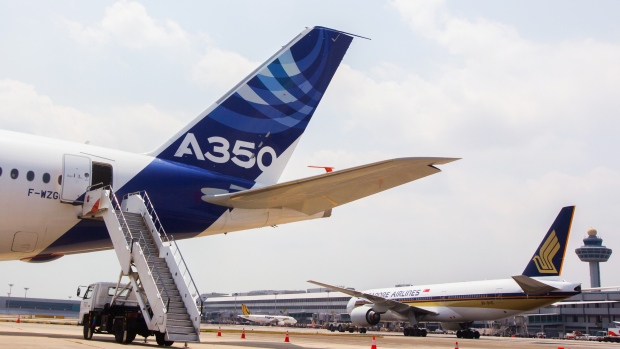Nov 21, 2018
Airbus staffing up for revamped A350 wide-body
, Bloomberg News

Airbus SE is hiring staff to help develop a proposed new narrow-body jet and a revamped version of its latest A350 wide-body, both due to be powered by a new generation of engine from the middle of next decade.
The company is recruiting designers and engineers in Toulouse and Madrid to work on the short-haul model, as well as a “new engine option” or Neo version of the A350, according to job postings seen by Bloomberg.
The short-range jet would be the first entirely new narrow-body that Airbus has brought to market since the A320 was offered to airlines in 1984, and the first clean-paper model of any kind from the European planemaker since the A350 was proposed in 2006. When asked about the job notices, Airbus said the projects described aren’t guaranteed to be launched or to enter production.
“As a leading aircraft manufacturer we are looking at many ways to advance our product line,” it said. “There are many studies, but not all see the light of day.” Airbus has in the past advertised jobs on a Neo version of the A380 superjumbo -- an upgrade that in 2016 was taken off the drawing board.
The latest job descriptions outline plans to develop digital replicas of production lines to test-run build rates of 100 narrow-bodies and 20 A350neos a month. The current target is 60 A320s a month by the middle of 2019, and 10 A350s by the end of this year.
Service entry for the models will be determined by developments in engine technology, with the Airbus ads specifying that both would be powered by turbines featuring ultra-high bypass ratios to reduce fuel burn.
Engine Rivals
Rolls-Royce Holdings Plc, Safran SA and Pratt & Whitney have all said they’re pursuing such designs. London-based Rolls-Royce has earmarked service entry in 2025 for its Ultrafan model, while France’s Safran is working on a demonstrator that will be ready for ground tests by 2021. Pratt, a unit of United Technologies Corp. is testing a similar upgrade of its geared turbofan.
Pratt competes with a Safran-General Electric Co. alliance to power existing A320 jets. A replacement model would provide Rolls with a chance to re-enter a narrow-body market it abandoned to focus on engines for bigger planes. Airbus, however, might not countenance three competing turbines and might want to see two groups formed.
Rolls in turn is the sole supplier of engines to the existing A350, and it’s not clear whether Airbus would be prepared to extend that exclusivity to a Neo version of the long-haul jet or want to bring in a competitor. That would give airlines more choice and help guard against the production stumbles that have afflicted some recent plane models in the industry.
Before embarking on the new aircraft, Airbus would first introduce two narrow-body upgrades, the job advertisements say.
One would be a version of the long range A321LR able to fly 700 nautical miles further with the aid of a redesigned fuel tank, dubbed the A321XLR. The other would be a stretched and improved version of the A320neo series known as the “plus” and aimed at helping Airbus compete with a planned mid-market plane that Boeing could launch as early as next year.





